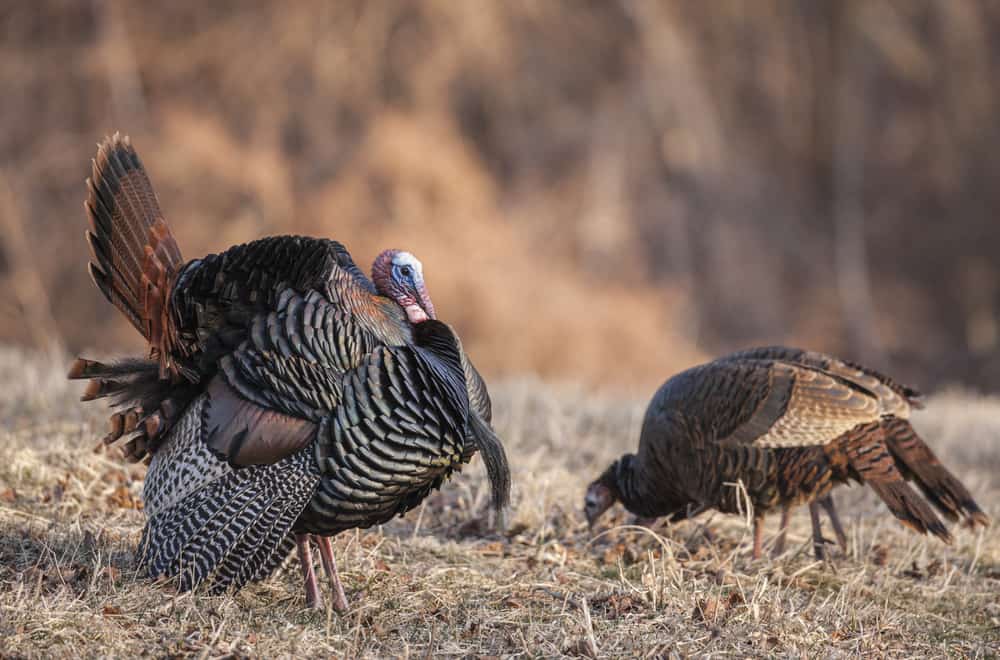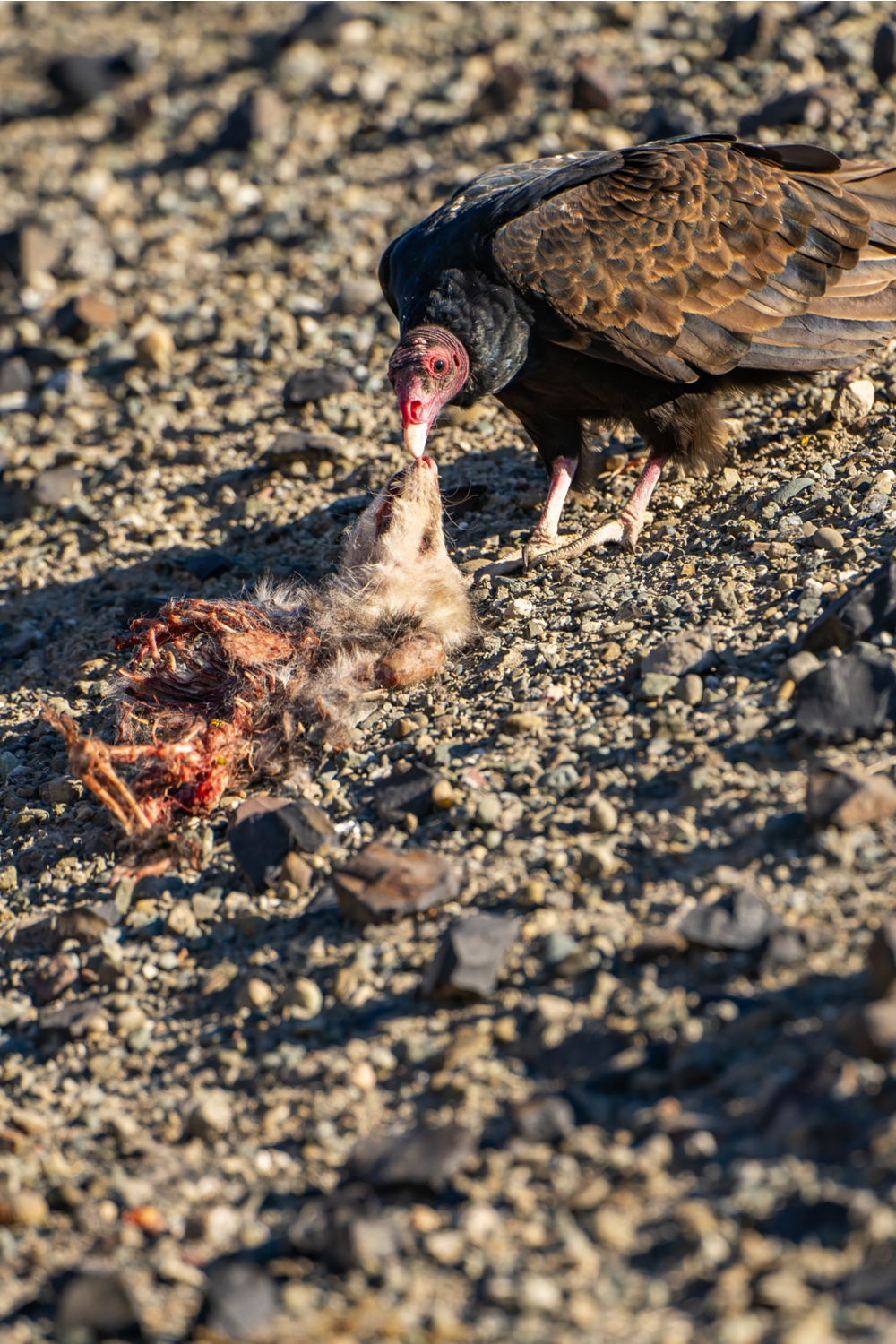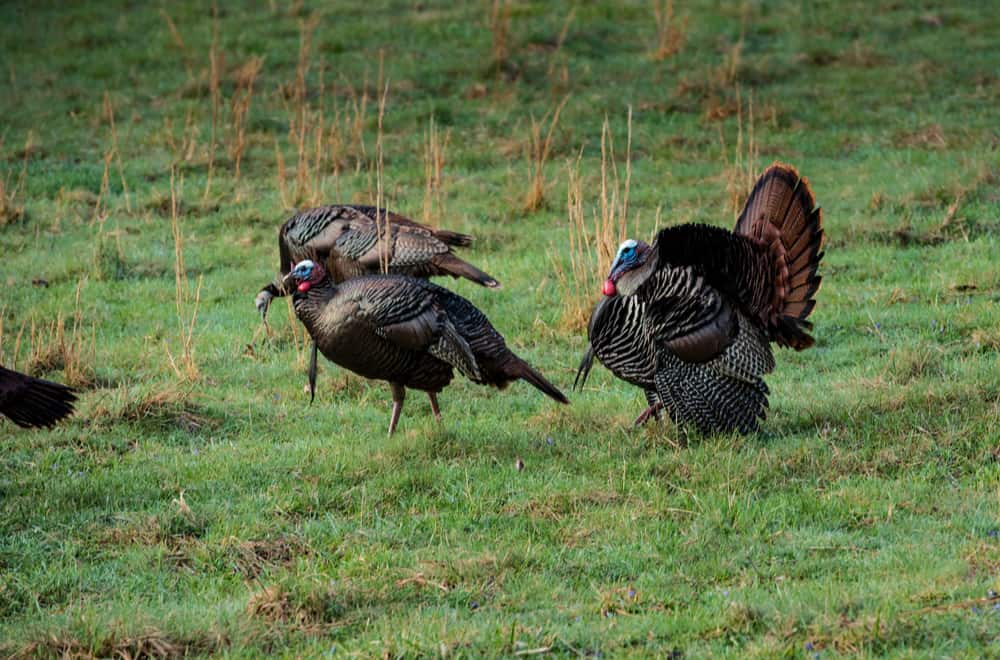Is It Illegal to Feed Wild Turkeys
Nothing says Thanksgiving than roasted turkey! But did you know the turkeys we eat at home are a tame version of wild turkeys? So, how about we pay tribute to these fascinating birds by learning key things about their game cousins like what they eat, how they behave, and how their daily life in the wild is like? Let's start.
Wild Turkey Habits and Biology

Wild turkeys, the ancestors of domesticated turkeys, are some of the largest game birds in North America. Although the two species are closely related, there are some notable differences between them. For example, wild turkeys can fly while their domesticated cousins cannot. Also, the feathers of wild turkeys are typically dark-colored, while those of domestic turkeys are white.
Like most bird species, wild turkeys have distinct features that make them stand out. One of the things that can be noticed at first glance is the red, meaty stretch of skin and bulgy bumps located around their neck and head area. These structures are referred to as the caruncles, snood, and wattle.
Male turkeys differ from their female counterparts in that they are larger and have colorful unfeathered necks and heads. They are also darker.
During courtship, adult males will enlarge their brightly colored snoods and caruncles to attract sexually mature females. The females find males with large wattles more attractive.
Sexually active males will gobble to attract females and send a warning to other males. During the breeding season, they will breed with multiple females, but once the season is over, they will form an all-male flock, leaving the females rearing the chicks by themselves.
Unlike most bird species, wild turkeys can live in one place for a long time. However, they do move about in search of food. They will wander mostly by walking but they can also run or even fly when their life is threatened.
Wild turkeys are active during the day. While they have excellent eyesight, their night vision is very poor and for the most part, they won't even see a predator approaching. As such, when the sun starts to set, the turkeys will fly into high tree limbs to roost. Most of the time, turkeys will roost in flocks but they can also do so individually.
What Do Wild Turkeys Eat In the Wild?

Wild turkeys are omnivorous. They will mostly eat plant matter they forage for on the ground, and sometimes they will climb into shrubs and other low trees to look for fruits. On occasion, they will consume small reptiles and amphibians.
But like most bird species, wild turkeys are opportunists, meaning, they will sample any food that is readily available. They will actively feed in the morning and in the evening just before dark. Where food is limited, the birds will forage all day long.
Wild turkeys will swallow their food whole and the food will be stored in their crop after which it will be digested in small portions. After feeding, wild turkeys will roost for a few hours while the food digests.
What Do Wild Turkeys Like to Eat?
Wild turkeys' diet will be determined by the time of the year. Here is what they will eat during different seasons:
Fall and early spring:
- acorns obtained from white oak
- red oak
- black oak
- and chestnut oak
- pecans
- American beech nuts
- wild black cherries
- white ash seeds
- hickory nuts
Winter:
- hemlock buds
- clubmosses
- evergreen ferns
- burdock
Late spring and summer:
- seeds from grasses and sedges
- snails
- salamanders
- ground beetles
Juvenile wild turkeys will mostly feed on small insects like grasshoppers, beetles, flies, and leafhoppers and invertebrates such as worms and spiders. Like most birds, wild turkeys will usually swallow grit to help with the digestion of food.
How Wild Turkeys' Diet Benefits the Ecosystem
- When wild turkeys move from one place to another, they take the seeds and nuts they had eaten with them and drop them at different places through their poop. This gives rise to new plants, replacing the ones that may have been destroyed by calamities of nature such as floods, soil erosion, and drought.
- Worms are a nightmare to farmers, many of whom depend on growing crops for their livelihood. The tiny critters take over fruits and berries, spending almost their entire lives inside and rendering these plant products unsellable and uneatable. When young wild turkeys feed on worms, they help reduce their population, promoting proper growth for fruits and berries.
- Juvenile wild turkeys feed on leafhoppers too, another group of pests that has been giving farmers sleepless nights. Leafhoppers live off the sap of fresh leaves. They pierce the leaves to get to the juice, leaving them with pale spots. If badly attacked, large plants will shed their leaves and small plants will die completely. Baby wild turkeys help keep leafhoppers in check, minimizing such attacks.
Facts About Wild Turkeys

1. Wild Turkeys Change Their Head Color to Communicate Emotions
The color of a wild turkey's head can change based on how the bird is currently feeling. Colors typically change to blue or red depending on how calm or excited the birds are. Ideally, the more intense a color appears, the stronger the bird's emotions.
2. Male Turkeys Are Aggressive During Mating Season
Sexually active male turkeys put in a lot of work into wooing females. They will not only fan out their beautiful tail feathers but also perform an elaborate dance to impress and attract females.
In addition, they will fight any other male that tends to show interest in their mate. In rare cases, aggressive males have been found to pick unnecessary fights with other game birds and even attack their own reflections.
3. Wild Turkeys Spend Their Time Both on Land and in Trees
While you are more likely to find wild turkeys roaming on the ground, these birds love to spend time in trees too. They will often pick the tallest and the healthiest, then settle as high as they can manage. They do this to protect themselves from predators. If the trees in their habitat are cut down, turkeys will seek out a new place with trees to roost on.
4. You Can Tell the Sex of Wild Turkeys By the Shape of Their Droppings
There are many ways to tell whether a wild turkey is male or female. For instance, the males are slightly bigger in size, have bright colors, and are more active, while the females have lighter colors and are calm in nature.
But there is also another way of differentiating male from female turkeys – checking their stool. Males will usually produce elongated J-shaped pieces of stool while females will leave shorter, rounded ones.
5. Wild Turkeys Have Better Vision Than Humans
Wild turkeys can see three times better than humans. They can easily rotate their heads, allowing for a 360° field of vision. This enables them to spot predators easily.
6. Male Wild Turkeys Gobble to Announce Their Presence
Both males and females make many sounds to communicate with others such as clucking, yelping, and purring, but males make an additional unique sound called gobble to make their presence known to other males.
Gobbling is typically a loud, descending trill that doesn't last any longer than one second. A male turkey makes this sound during the mating season to attract potential mates and keep other competing males at bay.
7. Wild Turkeys Almost Became Extinct in the 1930s
They were a popular target for hunters in the 30s and the population reduced to only 3% of its initial size. Restoring these birds took a considerable amount of time and resources, and this was only achieved after the Great Depression era and World War II.
Domesticated turkeys were taken to the wild to breed but couldn't survive and so their wild cousins were trapped and transferred thousands of miles where they were left to breed. Though it took over 20 years to increase the population, the efforts paid off and by the 1960s, the numbers had risen to 10 million, almost the original size.
8. Wild Turkeys Are Astonishingly Athletic
Wild turkeys move quite fast. They can run at a speed of 20 mph and fly up to 60 mph. They don't fly for long distances, though. They will mostly do a quarter mile then land on a tree or return to the ground, where they will spend the better part of their time.
Summary
Wild turkeys are regarded as generalist bird species because they can eat a wide range of foods. However, they prefer foraging for seeds, nuts, and insects on the ground but sometimes they will climb into low trees and shrubs for fruits and berries. Like most birds, though, their diet will be dependent on the time of the year.
Source: https://www.atshq.org/what-do-wild-turkeys-eat/